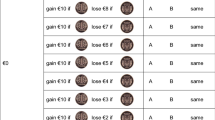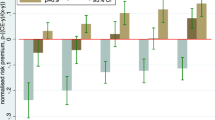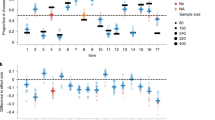Abstract
The introduction of the euro gave a unique opportunity to empirically disentangle two components of utility: intrinsic value, a rational component central in economics, and the numerosity effect (going by numbers while ignoring units), a descriptive and irrational component central in prospect theory and underlying the money illusion. We measured relative risk aversion in Belgium before and after the introduction of the euro, and could consider changes in intrinsic value while keeping numbers constant, and changes in numbers while keeping intrinsic value constant. Intrinsic value significantly affected risk aversion, and the numerosity effect did not. Our study is the first to confirm the classical hypothesis of increasing relative risk aversion while avoiding irrational distortions due to the numerosity effect.
Article PDF
Similar content being viewed by others
Avoid common mistakes on your manuscript.
References
Abdellaoui M. (2000). Parameter-free elicitation of utilities and probability weighting functions. Management Science 46: 1497–1512
Abdellaoui, M., Attema, A. E. and Bleichrodt, H. (2005a), Intertemporal Tradeoffs for Gains and Losses: An Experimental Measurement of Discounted Utility, iMTA/iBMG, Erasmus University, Rotterdam, the Netherlands.
Abdellaoui, M., Bleichrodt, H. and L’Haridon, O. (2007a), A Tractable Method to Measure Utility and loss aversion under prospect theory, in preparation, iMTA/iBMG, Erasmus University, Rotterdam, the Netherlands.
Abdellaoui, M., Bleichrodt, H. and Paraschiv, C. (2007b), Measuring loss aversion under prospect theory: A parameter-free approach, Management Science (forthcoming).
Abdellaoui M., Vossmann F., Weber M. (2005b). Choice-based elicitation and decomposition of decision weights for gains and losses under uncertainty. Management Science 51: 1384–1399
Allen F. (1987). Discovering personal probabilities when utility functions are unknown. Management Science 33: 542–544
Anscombe F.J., Aumann R.J. (1963). A definition of subjective probability. Annals of Mathematical Statistics 34: 199–205
Armantier O. (2006). Do wealth differences affect fairness considerations. International Economic Review 47: 391–429
Arrow K.J. (1971). Essays in the Theory of Risk Bearing. North-Holland, Amsterdam
Atkinson R.C., Herrnstein R.J., Lindzey G.E., Luce R.D. (eds) (1988). Stevens Handbook of Experimental Psychology (2nd ed). Wiley, New York
Baron J. (1997). Confusion of relative and absolute risk in valuation. Journal of Risk and Uncertainty 14: 301–309
Barron G., Erev I. (2003). Small feedback-based decisions and their limited correspondence to description-based decisions. Journal of Behavioral Decision Making 16: 215–233
Barsky R.B., Juster F.T., Kimball M.S., Shapiro M.D. (1997). Preference parameters and behavioral heterogeneity: An experimental approach in the health and retirement study. Quarterly Journal of Economics 112: 537–579
Battalio R.C., Kagel J.H., Jiranyakul K. (1990). Testing between alternative models of choice under uncertainty: Some initial results. Journal of Risk and Uncertainty 3: 25–50
Battalio R.C., Kagel J.H., MacDonald D.N. (1985). Animal’s choices over uncertain outcomes: Some initial experimental evidence. American Economic Review 75: 597–613
Benartzi S., Thaler R.H. (1995). Myopic loss aversion and the equity premium puzzle. Quarterly Journal of Economics 110: 73–92
Berg J.E., Daley L.A., Dickhaut J.W., O’Brien J.R. (1986). Controlling preferences for lotteries on units of experimental exchange. Quarterly Journal of Economics 101: 281–306
Binswanger H.P. (1981). Attitudes towards risk: Theoretical implications of an experiment in rural India. Economic Journal 91: 867–890
Bleichrodt H., Doctor J., Stolk E. (2005). A nonparametric elicitation of the equity-efficiency tradeoff in cost-utility. Journal of Health Econonomics 24: 655–678
Booij, A.S. and van de Kuilen, G. (2006), A Parameter-Free Analysis of the Utility of Money for the General Population under Prospect Theory, CREED, University of Amsterdam, the Netherlands.
Bornemann E. (1976). The Psychoanalysis of Money. Urizen Books, New York
Bruner J.S., Goodman C.C. (1947). Value and need as organizing factors in perception. Journal of Abnormal and Social Psychology 42: 33–44
Brysbaert M., Fias W., Noël M.-P. (1998). The whorfian hypothesis and numerical cognition: Is “twenty-four” processed in the same way as “four-and-twenty”?. Cognition 66: 51–77
Budescu D.V., Weiss W. (1987). Reflection of transitive and intransitive preferences: A test of prospect theory. Organizational Behavior and Human Decision Processes 39: 184–202
Camerer C.F. (1989). An experimental test of several generalized utility theories. Journal of Risk and Uncertainty 2: 61–104
Cohen M., Jaffray J.-Y., Said T. (1987). Experimental comparisons of individual behavior under risk and under uncertainty for gains and for losses. Organizational Behavior and Human Decision Processes 39: 1–22
Cohn R.A., Lewellen W.G., Lease R.C., Schlarbaum G.G. (1975). Individual investor risk aversion and investment portfolio composition. Journal of Finance 30: 605–620
Currim I.S., Sarin R.K. (1989). Prospect versus utility. Management Science 35: 22–41
Darke P.R., Freedman J.L. (1993). Deciding whether to seek a bargain: Effects of both amount and percentage off. Journal of Applied Psychology 78: 960–965
Davis D.D., Holt C.A. (1993), Experimental Economics. Princeton University Press, Princeton
Dickhaut J.W., McCabe K., Nagode J.C., Rustichini A., Smith K., Pardo J.V. (2003). The impact of the certainty context on the process of choice. Proceedings of the National Academy of Sciences 100: 3536–3541
Edwards W. (1954). The theory of decision making. Psychological Bulletin 51: 380–417
EOS Gallup Europe (2002), Euro attitudes—euro zone, flash Eurobarometer No 121/3, June 2002. URL: http://WWW.europa.eu.int/comm/ public_opinion/archives/flash_arch.htm
European Commission (2002), Eurobarometer—public opinion in the European union. Report no. 57, Spring 2002. URL: [http://europa.eu.int/ comm/dg10/epo/eb.html]
Fantino E., Goldshmidt J.N. (2000). Differences, not ratios, control choice in an experimental analogue to foraging. Psychological Science 3: 229–233
Fehr E., Tyran J.-R. (2001), Does money illusion matter?. American Economic Review 91: 1239–1262
Fennema H., van Assen M.A.L.M. (1998), Measuring the utility of losses by means of the tradeoff method. Journal of Risk and Uncertainty 17: 277–295
Fetherstonhaugh D., Slovic P., Johnson S.M., Friedrich J. (1997), Insensitivity to the value of human life: A study of psychophysical numbing. Journal of Risk and Uncertainty 14: 283–300
Fishburn P.C. and Kochenberger G.A. (1979), Two-piece von Neumann-Morgenstern utility functions. Decision Sciences 10: 503–518
Foltz G.S., Poltrock S.E. and Potts G.R. (1984), Mental comparison of size and magnitude: size congruity effects. Journal of Experimental Psychology: Learning, Memory and Cognition 10: 442–453
Forsythe R., Palfrey T.R. and Plott C.R. (1982), Asset valuation in an experimental market. Econometrica 50: 537–568
Friend I. and Blume M.E. (1975), The demand for risky assets. American Economic Review 65: 900–922
Furnham A. and Argyle M. (1998), The Psychology of Money. Routledge, London
Galanter, E. and Pliner, P. (1974), Cross-modality matching of money against other continua. In H. Moskowitz, B. Sharf, and J.C. Stevens (eds.), Sensation and Measurement: Papers in Honor of S.S. Stevens, Reidel, Dordrecht, the Netherlands, pp.65–76.
Gamble A., Gärling T., Charlton J.P. and Ranyard R. (2002), Euro illusion: Psychological insights into price evaluations with a unitary currency. European Psychologist 7: 302–311
González-Vallejo C.C., Reid A.A. and Schiltz J. (2003), Context effects: the proportional difference model and the reflection of preference. Journal of Experimental Psychology: Learning, Memory, and Cognition 29: 942–953
Harless D.W. and Camerer C.F. (1994), The predictive utility of generalized expected utility theories. Econometrica 62: 1251–1289
Harris L. (1991), Stock price clustering and discreteness. Review of Finance 16: 1533–1597
Harrison G.W. (1994), Expected utility theory and the experimentalists. Empirical Economics 19: 223–253
Harrison G.W., Johnson E., McInnes M.M. and Rutström E.E. (2005), Risk aversion and incentive effects: Comment. American Economic Review 95: 897–901
Harrison, G.W., Lau, M.I., and Rutström, E.E. (2006), Estimating risk attitudes in Denmark: A field experiment, Scandinavian Journal of Economics (forthcoming).
Harrison G.W., Lau M.I. and Williams M.B. (2002), Estimating individual discount rates in Denmark: A field experiment. American Economic Review 92: 1606–1617
Hershey J.C. and Schoemaker P.J.H. (1980), Prospect theory’s reflection hypothesis: A critical examination. Organizational Behavior and Human Performance 25: 395–418
Hogarth R.M. and Einhorn H.J. (1990), Venture theory: A model of decision weights. Management Science 36: 780–803
Holt C.A. (1986), Preference reversals and the independence axiom. American Economic Review 76: 508–513
Holt C.A. and Laury S.K. (2002), Risk aversion and incentive effects. American Economic Review 92: 1644–1655
Huber J., Ariely D., and Fischer G. (2001), Expressing preference in a principal-agent task: A comparison of choice, rating, and matching. Organizational Behavior and Human Decision Processes 87: 66–90
Jevons, W.S. (1889), The Theory of Political Economy (5th edition 1957, Kelley and MacMillan, New York; other ed. Penguin, 1970.)
Jonas E., Greitemeyer T., Frey D. and Schulz-Hardt S. (2002), Psychological effects of the euro—experimental research on the perception of salaries and price estimations. European Journal of Social Psychology 32: 147–169
Juliusson A., Gamble A., and Gärling T. (2006), Learning the value of a new currency from prices. Journal of Experimental Psychology: Applied 11: 45–52
Kachelmeier, S.J. and Shehata, M. (1992), Examining risk preferences under high monetary incentives: Experimental evidence from the people’s republic of China, American Economic Review 82, 1120–1141; for comment see Kachelmeier, S.J. and Shehata, M. (1994), American Economic Review 84, 1104–1106.
Kahneman D. (2003), A perspective on judgment and choice; mapping bounded rationality. American Psychologist 58: 697–720
Kahneman D. and Tversky A. (1979), Prospect theory: An analysis of decision under risk. Econometrica 47: 263–291
Kahneman D., Wakker P.P., and Sarin R.K. (1997), Back to Bentham? Explorations of experienced utility. Quarterly Journal of Economics 112: 375–405
Kirkpatrick L.A. and Epstein S. (1992), Cognitive-experiential self-theory and subjective probability: Further evidence for two conceptual systems. Journal of Personality and Social Psychology 63: 534–544
Kühberger A., Schulte-Mecklenbeck M., and Perner J. (1999), The effects of framing, reflection, probability, and payoff on risk preference in choice tasks. Organizational Behavior and Human Decision Processes 78: 204–231
Laury, S.K. and Holt, C.A. (2007), Further reflections on prospect theory. In Cox, J.C. and Harrison. G. (eds.), Risk Aversion in Experiments (Experimental Economics, Volume 12), JAI Press, Greenwich, CT, forthcoming.
Leontief W.W. (1936), The fundamental assumptions of Mr. Keynes’ monetary theory of unemployment. Quarterly Journal of Economics 5: 192–197
Levin I.P. and Hart S.S. (2003), Risk preferences in young children: Early evidence of individual differences in reaction to potential gains and losses. Journal of Behavioral Decision Making 16: 397–413
List J.A. (2006), Using Hicksian surplus measures to examine consistency of individual preferences: Evidence from a field experiment. The Scandinavian Journal of Economics 108: 115–134
Loehman E. (1998), Testing risk aversion and nonexpected utility theories. Journal of Economic Behavior and Organization 33: 285–302
Loewenstein G.F. and Prelec D. (1992), Anomalies in intertemporal choice: Evidence and an interpretation. Quarterly Journal of Economics 107: 573–597
Loomes G. (1998), Probabilities vs money: A test of some fundamental assumptions about rational decision making. Economic Journal 108: 477–489
Lopes L.L. and Oden G.C. (1999), The role of aspiration level in risky choice: A comparison of cumulative prospect theory and SP/A theory. Journal of Mathematical Psychology 43: 286–313
Marques J.F. (1999) Changing ‘Europe’—the euro as a new subject for psychological research in numerical cognition. European Psychologist 4: 152–156
Meier-Pesti K. and Kirchler E. (2003), Attitudes towards the euro by national identity and relative national status. Journal of Economic Psychology 24: 293–299
Müller-Peters A. (1998), The significance of national pride and national identity to the attitude toward the single European currency: A Europe-wide comparison. Journal of Economic Psychology 19: 701–719
Mussweiler T. and Englich B. (2003), Adapting to the euro: Evidence from bias reduction. Journal of Economic Psychology 24: 285–292
Myagkov M.G. and Plott C.R. (1997), Exchange economies and loss exposure: Experiments exploring prospect theory and competitive equilibria in market environments. American Economic Review 87: 801–828
Nestle F.O., Speidel H. and Speidel M.O. (2002), High nickel release from 1- and 2-euro coins. Nature 419: 132
Noël M.-P. and Serron X. (1997), On the existence of intermediate representations in numerical processing. Journal of Experimental Psychology: Learning, Memory, and Cognition 23: 697–720
Ogaki M. and Zhang Q. (2001), Decreasing relative risk aversion and tests of risk sharing. Econometrica 69: 515–526
Pelham B.W., Sumarta T.T, and Myaskovsky L. (1994), The easy path from many to much: The numerosity heuristic. Cognitive Psychology 26: 103–133
Pennings J.M.E. and Smidts A. (2003), The shape of utility functions and organizational behavior. Management Science 49: 1251–1263
Pepermans R., Burgoyne C.B., and Müller-Peters A. (1998), European integration, psychology and the euro. Journal of Economic Psychology 19: 657–661
Peters E., Västfjäll D., Slovic P., Mertz C.K., Mazzocco K., Dickert S. (2006), Numeracy and decision making. Psychological Science 17: 407–413
Plott C.R. (1986), Rational choice in experimental markets. Journal of Business 59: S301–S327
Plott C.R. and Sunder S. (1982), Efficiency of experimental security markets with insider information: An application of rational-expectations models. Journal of Political Economy 90: 663–698
Prelec D. and Loewenstein G.F. (1991), Decision making over time and under uncertainty: A common approach. Management Science 37: 770–786
Quattrone G.A. and Tversky A. (1988), Contrasting rational and psychological analyses of political choice. American Political Science Review 82: 719–736
Rabin M. (2000), Risk aversion and expected-utility theory: A calibration theorem. Econometrica 68: 1281–1292
Raghubir P. and Srivastava J. (2002), Effect of face value on product valuation in foreign currencies. Journal of Consumer Research 29: 335–347
Rapoport A. (1984), Effects of wealth on portfolios under various investment conditions. Acta Psychologica 55: 31–51
Roth A.E. and Malouf M.W. (1979), Game-theoretic models and the role of information in bargaining. Psychological Review 86: 574–594
Schneider S.L. and Lopes L.L. (1986), Reflection in preferences under risk: who and when may suggest why. Journal of Experimental Psychology: Human Perception and Performance 12: 535–548
Schunk D. and Betsch C. (2006), Explaining heterogeneity in utility functions by individual differences in decision modes. Journal of Economic Psychology 27: 386–401
Selten R., Sadrieh A. and Abbink K. (1999), Money does not induce risk neutral behavior, but binary lotteries do even worse. Theory and Decision 46: 211–249
Shafir E., Diamond P.A. and Tversky A. (1997), Money illusion. Quarterly Journal of Economics 112: 341–374
Smith K., Dickhaut J.W., McCabe K. and Pardo J.V. (2002), Neuronal substrates for choice under ambiguity, risk certainty, gains and losses. Management Science 48: 711–718
Smith V.L. (1982), Microeconomic systems as an experimental science. American Economic Review 72: 923–955
Soman, D., Wertenbroch, K., and Chattopadhyay, A. (2002), Currency numerosity effects on the perceived value of transactions, INSEAD, working paper 124/MKT, Fontainebleau, France.
Sonnemans J. (2006), Price clustering and natural resistance points in the Dutch stock market: A natural experiment. European Economic Review 50: 1937–1950
Starmer C. (2000), Developments in non-expected utility theory: The hunt for a descriptive theory of choice under risk. Journal of Economic Literature 38: 332–382
Starmer C. and Sugden R. (1991), Does the random-lottery incentive system elicit true preferences? An experimental investigation. American Economic Review 81: 971–978
Stenkula M. (2004), The euro cash changeover process. Kyklos 57: 265–286
Thaler R.H. (1980), Towards a positive theory of consumer choice. Journal of Economic Behavior and Organization 1: 39–60
Thaler R.H. (1985), Mental accounting and consumer choice. Marketing Science 4: 199–214
Tversky A. and Kahneman D. (1992), Advances in prospect theory: Cumulative representation of uncertainty. Journal of Risk and Uncertainty 5: 297–323
Wakker, P.P., Timmermans, D.R.M., and Machielse, I.A. (2006), The effects of information about probabilities on insurance decisions, Management Science, (forthcoming).
Weber E.U. and Bottom W.P. (1989), Axiomatic measures of perceived risk: Some tests and extensions. Journal of Behavioral Decision Making 2: 113–131
Zorzi, M., Priftis, K. and Umiltà, C. (2002), Neglect disrupts the mental number line, Nature, May, 417, 138–139.
Author information
Authors and Affiliations
Corresponding author
Rights and permissions
Open Access This is an open access article distributed under the terms of the Creative Commons Attribution Noncommercial License ( https://creativecommons.org/licenses/by-nc/2.0 ), which permits any noncommercial use, distribution, and reproduction in any medium, provided the original author(s) and source are credited.
About this article
Cite this article
Wakker, P.P., Köbberling, V. & Schwieren, C. Prospect-theory’s Diminishing Sensitivity Versus Economics’ Intrinsic Utility of Money: How the Introduction of the Euro can be Used to Disentangle the Two Empirically. Theor Decis 63, 205–231 (2007). https://doi.org/10.1007/s11238-007-9040-8
Received:
Accepted:
Published:
Issue Date:
DOI: https://doi.org/10.1007/s11238-007-9040-8




